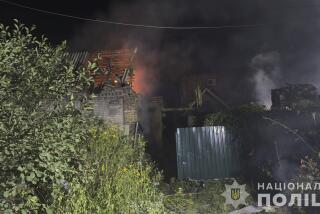5,000 Rebels Are in Iraq but U.S. ‘in Control,’ Chief Says
- Share via
WASHINGTON — Forces battling the U.S.-led military coalition in Iraq number about 5,000 and are well equipped, organized and financed, the head of the U.S. Central Command said Thursday.
Even so, Gen. John Abizaid, commander of U.S. and allied forces in Iraq, characterized his troops as “in control” of the military situation in the country.
In a briefing at Central Command headquarters in Tampa, Fla., Abizaid said the insurgents were a mix of former regime loyalists, religious and nationalist extremists, members of terrorist groups and a smaller number of foreign fighters.
Of those, the most potent threat comes from loyalists to former President Saddam Hussein’s Baath Party regime, Abizaid said.
“It is very important for us to close with that enemy, to discover their cellular structure, to unravel it and to remove that threat [to] moderation emerging in the Iraqi government,” Abizaid said.
Despite their relatively small numbers, the guerrillas have launched bold attacks in recent days, including nighttime mortar assaults on the heavily fortified compound housing the U.S.-led administration’s headquarters in Baghdad.
A suicide bombing Wednesday killed more than 30 people, including at least 18 Italians, in the southern city of Nasiriyah, which had been considered relatively stable and safe.
As Abizaid spoke in Tampa, U.S. forces in Baghdad were striking back at guerrilla targets with mortars, artillery and AC-130 Spectre gunships in a crackdown being called Operation Iron Hammer.
Abizaid acknowledged that there had been significant attacks on allied forces far outside the “Sunni Triangle,” a region of central Iraq that includes Baghdad and is considered a hotbed of anti-coalition activity.
The widening area of the attacks -- to Nasiriyah and Basra in the south and Mosul in the north -- “is part of a strategy to make people believe that nowhere is safe in Iraq,” Abizaid said.
No evidence has emerged that the attacks were coordinated on a national level, Abizaid said. However, money to finance them appears to have come both from sources inside Iraq and through foreign channels, he said.
“I believe that there is some level of coordination that’s taken place at very high levels, although I’m not so sure I’d say that there’s a national-level resistance leadership,” Abizaid said.
The commander said he believed Hussein was alive and was involved in coordinating some attacks against U.S. forces from inside Iraq. However, asked whether the deposed leader had planned the insurgency from the beginning, as suggested this week by one U.S. general, Abizaid scoffed.
“Saddam Hussein is one of the most incompetent military leaders in the history of the world,” he said. “And to give him any credit, to think that somehow or other he planned this, is absolutely beyond my comprehension.
“We do have resistance. It is organized, it is organizing, it’s organizing better,” Abizaid said. “But it’s not being done by any great plan of Saddam Hussein.”
U.S. forces said Thursday that they had rounded up dozens of Iraqis suspected of anti-American attacks in raids around Mosul and Hussein’s hometown of Tikrit.
In Tikrit, troops arrested six Iraqis suspected in attacks against helicopters, including two allegedly involved in last week’s downing of a Black Hawk that killed all six Americans on board, Associated Press reported. One was a police officer issued a badge by coalition forces, a military spokesman said.
In Baghdad, a spokesman for the U.S.-led administration said a key bridge reopened last month over the Tigris River near the authority’s headquarters would be closed for security reasons. Guerrillas have fired mortars at the U.S. base on several recent nights and soldiers reported killing several of them Thursday.
More to Read
Sign up for Essential California
The most important California stories and recommendations in your inbox every morning.
You may occasionally receive promotional content from the Los Angeles Times.












